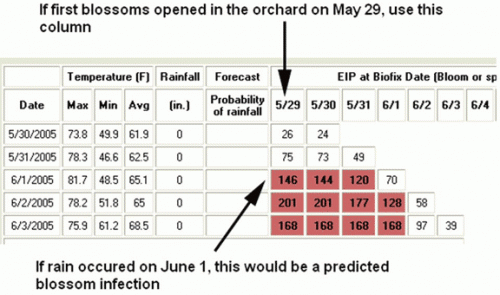How to use the Enviroweather Fire Blight Model
Editor’s note: This article is from the archives of the MSU Crop Advisory Team Alerts. Check the label of any pesticide referenced to ensure your use is included.
Growth of the fire blight pathogen is favored at temperatures over 65ºF. Degree hours using a base of 65ºF (DH65) are used to estimate fire blight bacterial population growth. To reach a level where fire blight can cause problems in the orchard, 198 degree hours (base 65ºF) from first bloom are needed to increase the population to a potentially dangerous level. These fire blight bacteria grow on the tip of the flower pistil (the stigma, which receives pollen grains), and once the population has built up on the stigma, a rain or heavy dew can wash the bacteria deep inside the flower where infection can take place.
The fire blight blossom model is based on the EIP value (Epiphytic Infection Potential), which is a way to express this heat unit accumulation on a 0 to 100 scale. ("Epiphytic" = plant surface). The EIP is calculated by dividing the current DH65 accumulation by 195 and then multiplying this by 100. If the DH65 reaches 195 (which also means that the EIP is 100), the bacteria have built up to a dangerous level, and a rain or heavy dew at this time will wash the bacterial down into the infection site and cause infection.
The current blossom blight model on Enviroweather also has the capacity to reduce the EIP value under cooler weather conditions by figuring in blossom life. In addition, the model reduces the EIP if the maximum temperature for a day is below 64ºF, because the fire blight bacteria require warm temperatures to grow. The EIP value is reduced by one-third by one cool day, another third by a second consecutive cool day, and to zero with a third. A day with freezing temperatures reduces the EIP to zero. However, once the EIP reaches 200, cool weather no longer reduces the accumulation.
The fire blight model is very different from other pest models in that it is based on degree “hours” rather than degree “days.” Since the threshold temperature for fire blight is 65ºF, we often go above that temperature for many hours in one day, so it takes a lot less time to collect degree hours above the threshold compared to collecting “daily” temperatures that average above 65ºF. Growers must be particularly diligent about checking the model because when temperatures change drastically during the day, the EIP can rise quickly and warrant a fire blight spray.
Therefore, at this time of the year, we need to be on the look out for weather conditions that favor fire blight, especially in susceptible varieties (See list of susceptible varieties). Infection can occur with a small amount of rain (or dew) following a warm period that allows bacterial populations to reach critical levels. The Enviroweather website has a reliable chart growers can use to determine if a fire blight control spray is needed:
- Click on www.enviroweather.msu.edu, go to the weather station closest to you, then to Fruit, then to Fire Blight of Apple Blossoms.
- Locate the biofix date (the date bloom first opened OR the date a spray was applied to control fire blight) on the top row.
- Follow that column down to determine Epiphytic Infection Potential (EIP) for that block on each date in the left column. If this number is greater than 100, and the average temperature is greater than or equal to 60ºF, this area will be shaded and rain or trauma (high winds or hail) is all that is needed for infection.
At this time of year, it is particularly difficult to gauge fire blight infection potential as we often have warm and rainy weather, but we don’t want to waste an antibiotic spray if it is not truly necessary. If the fire blight model’s EIP is close to but not at 100, there are a few rules of thumb to determine if an antibiotic application is warranted: 1) a block with a history of fire blight, 2) susceptible varieties, or 3) visible cankers are all good reasons to go into a rainy period with an antibiotic spray.
Susceptible varieties
Gala, Fuji, Jonathan, Rome, Idared, Ginger Gold, Mutsu (Crispin), Rhode Island Greening, Paulared

Interpreting the Enviroweather chart
First pick the column that best corresponds to the first day blossoms opened in your orchard (see figure). The numbers in the squares gives the EIP (Epiphytic Infection Potential) for these blossoms. Bacterial populations (larger EIP) build on days with temperatures over 65ºF. When the EIP reaches 100, a rain or trauma event (strong wind or hail) will initiate a blossom infection. The higher the EIP, the greater is the risk of infection with rain or trauma.
Dr. Sundin's work is funded in part by MSU's AgBioResearch.



 Print
Print Email
Email




